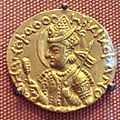Huvishka
| Huvishka | |
|---|---|
| Kushan emperor | |
 Coin of Huvishka. Legend in Kushan language and Greek script (with the Kushan letter Ϸ "sh"): ϷΑΟΝΑΝΟϷΑΟ ΟΟΗϷΚΙ ΚΟϷΑΝΟ ("Shaonanoshao Ooishki Koshano"): "King of kings, Huvishka the Kushan". | |
| Reign | 140–180 CE |
| Predecessor | Kanishka |
| Successor | Vasudeva I |
Huvishka (Kushan: Οοηϸκι, "Ooishki") was the emperor of the Kushan Empire from the death of Kanishka (assumed on the best evidence available to be in 140 CE) until the succession of Vasudeva I about forty years later. His rule was a period of retrenchment and consolidation for the Empire. In particular he devoted time and effort early in his reign to the exertion of greater control over the city of Mathura. Mathura represented the southernmost extent of the Empire and, like much of the Indian Subcontinent, had been ruled via a series of subordinate rulers. These rulers, the ksatraps, maintained a certain amount of autonomy up under Kanishka, but they vanish from records in Huvishka's reign, while Huvishka patronised both Buddhist and Brahmin institutions in the town.
Religion
Huvishka was the son of Kanishka. His reign is also known as the golden age of Kushan rule. The reign of Huvishka corresponds to the first known epigraphic evidence of the Buddha Amitabha, on the bottom part of a 2nd-century statue which has been found in Govindo-Nagar, and now at the Mathura Museum. The statue is dated to "the 28th year of the reign of Huvishka", and dedicated to "Amitabha Buddha" by a family of merchants. There is also some evidence that Huvishka himself was a follower of Mahāyāna Buddhism. A Sanskrit manuscript fragment in the Schøyen Collection describes Huvishka as one who has "set forth in the Mahāyāna."[1]
Compared to his predecessor Kanishka, Huvishka seems to rely less on Iranian deities (which are much less numerous in his coinage), and more on India ones, such as war divinities of Shivaism.
He also incorporates in his coins for the first and unique time in Kushan coinage the Hellenistic-Egyptian Serapis (under the name Σαραπο, "Sarapo" [2]), and the Goddess Roma (thought to represent "Roma aeterna"), under the name "Riom" (Greek: ΡΙΟΜ).[3]
Coinage

|
|
|
One of the great remaining puzzles of Huvishka's reign is the devaluation of his coinage. Early in his reign the copper coinage plunged in weight from a standard of 16g to about 10-11g. The quality and weight then continued to decline throughout the reign until at the start of the reign of Vasudeva the standard coin (a tetradrachm) weighed only 9g. The devaluation led to a massive production of imitations, and an economic demand for the older, pre-devaluation coins in the Gangetic valley. However, the motivation (and even some of the details) of this devaluation are still unknown.
Bodh Gaya
Decorated coins of Huvishka were found at Bodh Gaya together with other gold offerings under the "Enlightenment Throne" of the Buddha. This would tend to suggest direct Kushan influence in the area during the 3rd century CE.[4]
Notes
- ↑ Neelis, Jason. Early Buddhist Transmission and Trade Networks. 2010. p. 141
- ↑ Serapis coin
- ↑ Mario Bussagli, "L'Art du Gandhara", 225
- ↑ British Museum display, Asian Art room.
External links
- Online Catalogue of Huvishka's Coinage
- Coins of Huvishka
- Was Huvishka sole king of the Kushan Empire
- The Devaluation of the Coinage of Kanishka
| Preceded by Kanishka |
Kushan Ruler 140–183 CE |
Succeeded by Vasudeva I |


